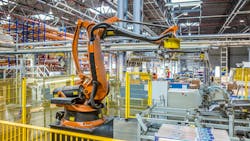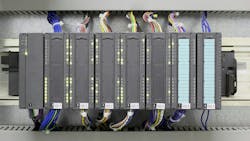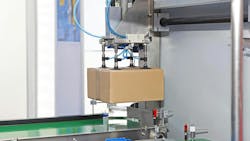Closing the Loop: How Real-Time Motion Feedback is Reshaping Industrial Automation
What you'll learn:
- The definition of real-time motion feedback and how it is used in industrial automation.
- The benefits which can be achieved by utilizing real-time motion feedback.
- Best practices for employing real-time motion feedback.
In the rapidly evolving world of industrial automation, precision and adaptability are essential. At the heart of this transformation lies real-time motion feedback, a cornerstone of closed-loop control systems that is redefining how machines respond to dynamic environments.
For engineers, designers, and technicians, understanding how real-time motion feedback works is critical to building smarter, faster, and more resilient automation systems.
Understanding Real-Time Motion Feedback
This article is the first in a two-part series examining the benefits real-time motion feedback can provide to industrial applications as well as their hydraulic, pneumatic and electromechanical motion control systems. Read the second article "Closing the Loop: Real-Time Motion Feedback Improves Prototyping and Injection Molding" to learn more about how real-time motion feedback is helping overcome challenges commonly associated with prototyping and injection molding to improve the overall manufacturing process.
If a deviation is detected, the controller sends corrective signals to the actuators — whether hydraulic, pneumatic or electric — to bring performance back within tolerance, closing the loop.
This closed-loop approach contrasts with open-loop systems, which operate without feedback and cannot self-correct. While open-loop systems are sufficient for simple, low-precision tasks, they fall short in complex environments where real-time adaptability and accuracy are critical.
The Impact of Closed-Loop Systems on Industrial Precision
One of the primary benefits of closed-loop systems is increased precision. In high-performance applications such as CNC machining, semiconductor fabrication, robotics, and automated assembly lines, minute discrepancies in motion can lead to quality defects, wasted materials, and lost time.
Real-time feedback enables a range of benefits, including:
- sub-micron position accuracy in multiaxis machine tools;
- stable trajectory control in pick-and-place robots;
- minimized overshoot and oscillations in servo systems; and
- predictable repeatability in coordinated motion sequences.
Enhancing Efficiency and Productivity
Beyond precision, real-time motion feedback contributes significantly to operational efficiency. Adaptive control algorithms, fueled by instantaneous data, can adjust parameters on the fly, reducing cycle times and energy usage.
For instance, intelligent servo drives with embedded feedback mechanisms can ramp down motor torque during idle phases or speed up motion profiles when the system is underutilized.
This efficiency gains further momentum when closed-loop control is integrated into larger manufacturing ecosystems. With the help of an industrial networking solution, feedback data from multiple motion subsystems can be shared, analyzed, and synchronized across a plant or even between sites.
This connectivity paves the way for predictive maintenance, real-time process optimization, and seamless coordination between different stages of production.
Watch our interview below with Jesse Dupuis, Director – Powertrain Product Management, Motion Control Solutions at Regal Rexnord, to learn more about how efficient systems can improve operational costs.
Real-Time Feedback Benefits Robotics and Collaborative Systems
As collaborative robots (cobots) and autonomous guided vehicles (AGVs) become more prevalent, the importance of real-time motion feedback grows. In these applications, safety and responsiveness are paramount.
Real-time feedback enables soft-touch interactions, compliant motion, and force-limiting behaviors that allow machines to safely share workspaces with humans.
Technologies such as force-torque sensors, integrated encoders, and advanced motor drives work together to ensure that robotic systems can detect and react to contact, resistance, or changes in payload. These abilities are essential for flexible automation systems that must adapt to variable tasks and unstructured environments.
Integration with Industrial Networking Solutions a Key Design Component
To fully harness the benefits of real-time feedback, motion systems must communicate effectively with other components and control layers. This is where the role of an industrial networking solution becomes indispensable.
Communication protocols such as EtherCAT, PROFINET, and Ethernet/IP enable high-speed, deterministic data exchange between sensors, drives, controllers, and supervisory systems. These networks support diagnostics and remote monitoring, making it easier for technicians to troubleshoot, update, and maintain equipment without disrupting production.
Industrial networking ensures:
- Low-latency communication between motion components and PLCs.
- Deterministic synchronization for multi-axis coordination.
- Seamless data sharing for MES and SCADA integration.
- Scalability and modularity for expanding automation architectures.
Adapting to Change with Closed-Loop Flexibility
Modern production lines face constant pressure to adapt — new product variants, customized orders, and frequent changeovers are the norm. Closed-loop systems with real-time feedback offer the flexibility to accommodate such variability without sacrificing quality or uptime.
For example, servo motors with feedback can adapt automatically to different load profiles or trajectory paths when switching between product types. Similarly, packaging machinery with integrated vision and motion feedback can identify and adjust to different package sizes or orientations without manual intervention.
This level of responsiveness is critical for engineers and designers seeking to create future-proof systems that can evolve with market demands.
Predictive Maintenance and Data-Driven Insights Through Real-Time Feedback
Another transformative advantage of real-time motion feedback is its role in predictive maintenance. By continuously monitoring performance metrics such as vibration, backlash, or thermal drift, motion systems can detect early signs of wear or misalignment.
When combined with machine learning algorithms and a robust networking solution, this feedback can be analyzed to forecast component failure and schedule maintenance proactively.
This approach minimizes unplanned downtime, reduces maintenance costs, and extends equipment life, providing tangible ROI for operations teams and reliability engineers alike.
Engineering Considerations for Implementation of Real-Time Motion Feedback
When designing motion systems with real-time feedback, several technical factors must be considered:
- Sensor Selection: Choose the appropriate resolution, accuracy, and environmental rating based on the application.
- Controller Compatibility: Ensure feedback signals are supported by motion controllers and integrated software.
- Signal Integrity: Use shielded cables and proper grounding to protect sensitive feedback signals from electrical noise.
- Calibration and Alignment: Proper setup and alignment are essential to ensure accurate feedback data and system performance.
- Latency and Update Rates: Evaluate the response time of feedback loops relative to system dynamics to avoid instability or lag.
The Future of Closed-Loop Automation
As industrial automation continues to evolve, the demand for intelligent, adaptive, and resilient systems will only grow. Real-time motion feedback stands at the center of this evolution, enabling machines to self-correct, self-optimize, and interact seamlessly with their environments.
Emerging technologies such as edge computing, artificial intelligence (AI) driven control algorithms, and digital twins will further expand the possibilities of closed-loop systems.
By combining rich motion feedback with powerful analytics and an agile industrial networking solution, engineers and technicians will be able to design next-generation automation systems that are not only precise and efficient but also autonomous and self-improving.
In industrial automation, the shift from reactive to proactive control is a defining trend. Real-time motion feedback is the enabler that makes this shift possible. For engineers, designers, and technicians, understanding how to implement and optimize closed-loop systems is a fundamental part of future-ready engineering.
This article was written and contributed by Steve Orth, Vice President of Engineering at EOSYS Group, an industrial system integration services provider.
About the Author
Steve Orth
Vice President of Engineering, EOSYS Group
Steve Orth is Vice President of Engineering at EOSYS Group which offers industrial system integration services. EOSYS is a 100% employee-owned company delivering automation, digital transformation, and operational technology solutions to industries such as automotive, food and beverage, chemicals, and utilities. A Rockwell Automation Platinum System Integrator Partner and CSIA-certified member, EOSYS is known for its commitment to quality and innovation.

Leaders relevant to this article:



